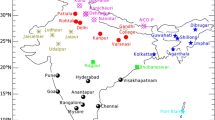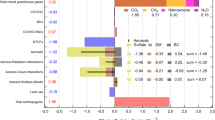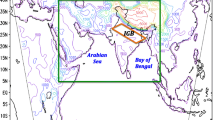Abstract
The direct and semi-direct radiative effects of anthropogenic aerosols on the radiative transfer and cloud fields in the Western United States (WUS) according to seasonal aerosol optical depth (AOD) and regional climate are examined using a regional climate model (RCM) in conjunction with the aerosol fields from a GEOS-Chem chemical-transport model (CTM) simulation. The two radiative effects cannot be separated within the experimental design in this study, thus the combined direct- and semi-direct effects are called radiative effects hereafter. The CTM shows that the AOD associated with the anthropogenic aerosols is chiefly due to sulfates with minor contributions from black carbon (BC) and that the AOD of the anthropogenic aerosol varies according to local emissions and the seasonal low-level winds. The RCM-simulated anthropogenic aerosol radiative effects vary according to the characteristics of regional climate, in addition to the AOD. The effects on the top of the atmosphere (TOA) outgoing shortwave radiation (OSRT) range from −0.2 Wm−2 to −1 Wm−2. In Northwestern US (NWUS), the maximum and minimum impact of anthropogenic aerosols on OSRT occurs in summer and winter, respectively, following the seasonal AOD. In Arizona-New Mexico (AZNM), the effect of anthropogenic sulfates on OSRT shows a bimodal distribution with winter/summer minima and spring/fall maxima, while the effect of anthropogenic BC shows a single peak in summer. The anthropogenic aerosols affect surface insolation range from −0.6 Wm−2 to −2.4 Wm−2, with similar variations found for the effects on OSRT except that the radiative effects of anthropogenic BC over AZNM show a bimodal distribution with spring/fall maxima and summer/winter minima. The radiative effects of anthropogenic sulfates on TOA outgoing longwave radiation (OLR) and the surface downward longwave radiation (DLRS) are notable only in summer and are characterized by strong geographical contrasts; the summer OLR in NWUS (AZNM) is reduced (enhanced) by 0.52 Wm−2 (1.14 Wm−2). The anthropogenic sulfates enhance (reduce) summer DLRS by 0.2 Wm−2 (0.65 Wm−2) in NWUS (AZNM). The anthropogenic BC affect DLRS noticeably only in AZNM during summer. The anthropogenic aerosols affect the cloud water path (CWP) and the radiative transfer noticeably only in summer when convective clouds are dominant. Primarily shortwave-reflecting anthropogenic sulfates decrease and increase CWP in AZNM and NWUS, respectively, however, the shortwave-absorbing anthropogenic BC reduces CWP in both regions. Due to strong feedback via convective clouds, the radiative effects of anthropogenic aerosols on the summer radiation field are more closely correlated with the changes in CWP than the AOD. The radiative effect of the total anthropogenic aerosols is dominated by the anthropogenic sulfates that contribute more than 80% of the total AOD associated with the anthropogenic aerosols.










Similar content being viewed by others
References
Alexander B, Savarino J, Lee C, Park RJ, Jacob DJ, Thiemens MH, Li Q, Yantosca RM (2005) Sulfate formation in sea-salt aerosols: constraints from oxygen isotopes. J Geophys Res 110:D10307. doi:10.1029/2004JD005659
Boucher O, Anderson T (1995) GCM assessment of the sensitivity of direct climate forcing by anthropogenic sulfate aerosols to aerosol size and chemistry. J Geophys Res 100:26061–26092
Chang S, Hahn D, Yang C, Norquist D, Ek M (1999) Validation study of the CAPS model land surface scheme using the 1987 Cabauw/PILPS dataset. J Appl Meteor 38:405–422
Cho H, Niewiadomski M, Iribarne J, Mello O (1989) A model of the effective cumulus clouds on the redistribution and transportation of pollutants. J Geophys Res 94:12895–12910
d’Almeida GA, Koepke P, Shettle EP (1991) Atmospheric aerosols - global climatology and radiative characteristics. A. Deepak Publishing, Hampton, Virginia, p 561
Deardorff JW (1978) Efficient prediction of ground surface temperature and moisture, with inclusion of a layer of vegetation. J Geophys Res 83:1889–1903
Fairlie TD, Jacob DJ, Park RJ (2007) The impact of transpacific transport of mineral dust in the United States. Atmos Environ. doi:10.1016/j.atmosenv.2006.09.048
Fu Q, Liou KN (1992) On the correlated k-distribution method for radiative transfer in nonhomogeneous atmospheres. J Atmos Sci 49:2139–2156
Fu Q, Liou KN (1993) Parameterization of the radiative properties of cirrus clouds. J Atmos Sci 50:2008–2025
Fu Q, Liou KN, Cribb MC, Charlock TP, Grossman A (1997) Multiple scattering parameterization in thermal infrared radiative transfer. J Atmos Sci 54:2799–2812
Giorgi F, Bi X, Qian Y (2002) Direct radiative forcing and regional climate effects of anthropogenic aerosols over East Asia: a regional coupled climate-chemistry/aerosol model study. J Geophys Res 107:4439. doi:10.1029/2001JD001066
Gu Y, Farrara JD, Liou KN, Mechoso CR (2003) ‘Parameterization of cloud/radiation processes in the UCLA general circulation model. J Clim 16:3357–3370
Gu Y, Liou KN, Xue Y, Mechoso CR, Li W, Luo Y (2006) Climatic effects of different aerosol types in China simulated by the UCLA general circulation model. J Geophys Res 111:D15201. doi:10.1029/2005JD006312
Gueymard CA, Laulainen CNS, Vaughan JK, Vignola FE (2000) ‘China’s dust affects solar resource in the U. S.: A case study’, SOLAR 2000, Proceedings of ASES Annual Conference, June 16–21.
Hess M, Koepke P, Schult I (1998) Optical properties of aerosols and clouds: the software package OPAC. Bull Amer Meteor Soc 79:831–844
Higgins RW, Yao Y, Wang X (1997) Influence of the North American monsoon system on the U.S. summer precipitation regime. J Clim 10:2600–2622
Hong S, Pan H (1998) Convective trigger function for a mass flux cumulus parameterization scheme. Mon Weather Rev 126:2599–2620
Huang Y, Chameides WL, Dickinson RE (2007) Direct and indirect effects of anthropogenic aerosols on regional precipitation over east China. J Geophys Res 112:D03212. doi:10.1029/2006JD007114
Johnson BT (2005) The semidirect aerosol effect: comparison of a single-column model with large-eddy simulation for marine stratocumulus. J Clim 18:119–130
Johnson BT, Shine KP, Forster PM (2006) The semi-direct aerosol effect: impact of absorbing aerosols on marine stratocumulus. Q J R Meteorol Soc 130:1407–1422
Kanamitsu M, Kumar A, Juang H, Schemm J, Wang W, Yang F, Hong S, Peng P, Chen W, Moorthi S, Ji M (2002) NCEP dynamical seasonal forecast system 2000. Bull Am Meteorol Soc 83:1019–1037
Kim J (1990) Turbulent and gravity wave transport in the free atmosphere. Ph.D. Thesis, Dept. Atmospheric Sciences, Oregon State University, Corvallis, Oregon, 103 pp.
Kim J (1997) Precipitation and snow budget over the southwestern United States during the 1994–1995 winter season in a mesoscale model simulation. Water Resour Res 33:2831–2839
Kim J (2001) A nested modeling study of elevation-dependent climate change signals in California induced by increased atmospheric CO2. Geophys Res Lett 28:2951–2954
Kim J (2002) Precipitation variability associated with the North American Monsoon in the 20th century. Geophys Res Lett 29:1650. doi:10.1029/2001GL014316
Kim J (2005) A projection of the effects of the climate change induced by increased CO2 on extreme hydrologic events in the western U.S. Clim Chang 68:153–168
Kim J, Mahrt L (1992) Simple formulation of turbulent mixing in the stable free atmosphere and nocturnal boundary layer. Tellus 44A:381–394
Kim J, Ek M (1995) A simulation of the surface energy budget and soil water content over the hydrologic atmospheric pilot experiments-Modelisation du Bilan Hydrique forest site. J Geophys Res 100:20845–20854
Kim J, Lee J-E (2003) A multiyear regional climate hindcast for the western United States using the mesoscale atmospheric simulation model. J Hydrometeorol 4:878–889
Kim J, Miller N, Guetter A, Georgakakos K (1998) River flow response to precipitation and snow budget in California during the 1994–1995 winter. J Clim 11:2376–2386
Kim J, Miller N, Farrara JD, Hong S (2000) A numerical study of precipitation and streamflow in the western United States during the 1997–98 winter season. J Hydrometeorol 1:311–329
Kim J, Kim T, Arritt RW, Miller NL (2002) ‘Impacts of increased atmospheric CO2 on the hydroclimate of the western United States. J Clim 15:1926–1942
Kim J, Kim J, Farrara JD, Roads JO (2005) The effects of the Gulf of California SSTs on warm-season rainfall in the southwestern United States and northwestern Mexico: a regional model study. J Clim 18:4970–4992
Kim J, Gu Y, Liou KN (2006) The impact of the direct aerosol radiative forcing on surface insolation and spring snowmelt in the southern Sierra Nevada. J Hydrometeorol 7:976–983
Liou KN, Fu Q, Ackerman TP (1988) A simple formulation of the delta-four-stream approximation for radiative transfer parameterizations. J Atmos Sci 45:1940–1947
Louis J, Tiedke M, Gelvyn J (1982) A short history of the operational PBL-parameterization at ECMWF. Workshop on Planetary Boundary Layer Parameterization, 59–79, ECMWF, 260 pp.
Luo Y, Lu D, He Q, Wang F (2000) An analysis of direct solar radiation, visibility and aerosol optical depth in south China coastal area (in Chinese). Clim Environ Res 5:36–44
Mahrt L, Pan H (1984) A two-layer model of soil hydrology. Bound-Layer Meteorol 29:1–20
Menon S, Hansen J, Nazarenko L, Luo Y (2002) Climate effects of black carbon aerosols in China and India. Science 297:2250–2253
Mitchell J, Johns T, Gregory J, Tett S (1995) Climate response to increasing levels of greenhouse gases and sulfate aerosols. Nature 376:501–504
Pan H, Mahrt L (1987) Interaction between soil hydrology and boundary layer development. Bound-Layer Meteorol 38:185–202
Pan H, Wu W (1995) Implementing a mass flux convection parameterization package for the NCEP medium-range forecast model. NMC Office Note, 40 pp. NCEP/EMC, 5200 Auth Road, Camp Springs, MD 20764, USA
Pan W, Tatang A, McRae GJ, Prinn RG (1997) Uncertainty analysis of direct radiative forcing by anthropogenic sulfate aerosols. J Geophys Res 102:21915–21924
Park RJ, Jacob DJ, Chin M, Martin R (2003) Sources of carbonaceous aerosols over the United States and implications for natural visibility. J Geophys Res 108(D12):4355. doi:10.1029/2002JD003190
Park RJ, Jacob DJ, Field BD, Yantosca RM, Chin M (2004) Natural and transboundary pollution influences on sulfate-nitrate-ammonium aerosols in the United States: implications for policy. J Geophys Res 109:D15204. doi:10.1029/2003JD004473
Park RJ, Jacob DJ, Kumar N, Yantosca RM (2006) Regional visibility statistics in the United States: natural and transboundary pollution influences, and implications for the Regional Haze Rule. Atmos Environ 40(28):5405–5423
Park RJ, Jacob DJ, Logan JA (2007) Fire and biofuel contributions to annual mean aerosol mass concentrations in the United States. Atmos Environ 41:7389–7400
Pitchford ML, Tombach I, Barna M, Gebhart KA, Green MC, Knipping EM, Kumar N, Malm WC, Pun B, Schichtel BA, Seigneur C (2004) Big bend regional aerosol and visibility observational study (BRAVO); final report. U.S. EPA Region VI, Dallas, Texas
Soong S, Kim J (1996) Simulation of a heavy wintertime precipitation event in California. Clim Chang 32:55–77
Takacs L (1985) A two-step scheme for the advection equation with minimized dissipation schemes. J Atmos Sci 35:2123–2132
Tegen I, Fung I (1995) Contribution to the atmospheric mineral aerosol load from land surface modification. J Geophys Res 100:18707–18726
Tegen I, Lacis AA (1996) Modeling of particle size distribution and its influence on the radiative properties of mineral dust aerosol. J Geophys Res 101:19237–19244
Wang Y, McElroy M, Wang T, Palmer P (2004) Asian emissions of CO and NOx: constraints from aircraft and Chinese station data. J Geophys Res 109:D24304
Xu Q (2001) Abrupt change of the mid-summer climate in central east China by the influence of atmospheric pollution. Atmos Environ 35:5029–5040
Acknowledgements
This study was supported by the grants from NOAA/GAPP (NA03OAR4310012), NASA Applied Sciences Program (NAG5-13248), NSF ATM-0437349 and ATM-0924876, National Comprehensive Measures against Climate Change Program of Ministry of Environment, Republic of Korea (Grant No. 1600-1637-301-210-13), and the Korea Meteorological Administration Research and Development Program under the grant CATER 2007–3205.
Author information
Authors and Affiliations
Corresponding author
Rights and permissions
About this article
Cite this article
Kim, J., Gu, Y., Liou, KN. et al. Direct and semi-direct radiative effects of anthropogenic aerosols in the Western United States: Seasonal and geographical variations according to regional climate characteristics. Climatic Change 111, 859–877 (2012). https://doi.org/10.1007/s10584-011-0169-7
Received:
Accepted:
Published:
Issue Date:
DOI: https://doi.org/10.1007/s10584-011-0169-7




